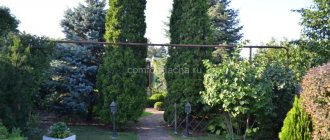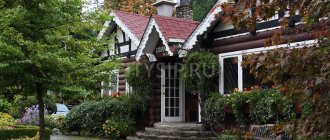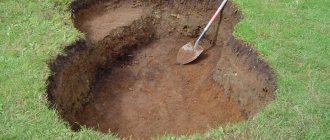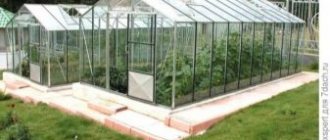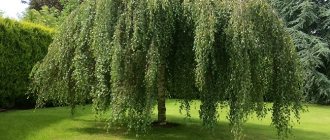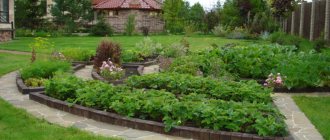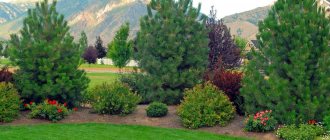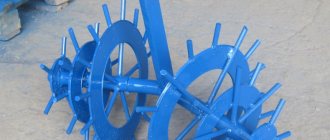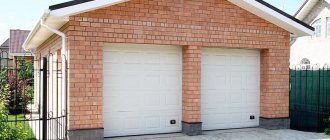The cost of good seedlings is not comparable to the mental and material expenses that arise in the event of death or poor growth of young plants.
Therefore, before planting trees with your own hands, it is important to learn a few rules regarding which seedlings to choose, when and how to plant pears, cherries and apples in your summer cottage.
Planting fruit trees in spring
Choosing a landing site
If you plan to plant fruit trees on your personal plot, then you need to choose the right place for planting and neighbors for the tree. It is advisable to draw a diagram of the site, which will accurately indicate the location of fruit crops and all points of future work.
First, decide on the types and varieties of trees. After this, draw up a planting plan, indicating for each species its distinctive features:
- maximum tree height to take into account the degree of shading of neighboring crops;
- type of tree crown to prevent crowding of plantings;
- when fruiting begins - the ripening period is early, medium or late to ensure proper care.
Additionally, enter into the diagram the approximate distance between crops to prevent close proximity between tall and spreading trees and small shrubs, as in this case they will begin to disappear. The distance is calculated as follows:
- Medium and tall trees with a wide crown should grow in an area whose perimeter is at least 10 m by 10 m.
- The perimeter of the site for dwarf trees is 5 m by 5 m.
- The perimeter of the plot for columnar crops is 2 m by 2 m.
It is also important to remember about the correct selection of neighbors, because not all trees are able to get along peacefully with each other.
Follow these rules:
- Plant pear, plum, quince and cherry trees next to the apple tree. And don’t plant viburnum and cherries.
- Rowan and apple trees feel good next to the pear tree. But growing a tree next to plum, cherry and viburnum is not recommended.
- Cherries and plums get along well next to an apple tree. But we do not recommend planting them next to pear trees.
↑ Video about ornamental trees for your garden
To arrange a garden, everyone chooses their own path: some gardeners plant only fruit crops, others only coniferous trees and shrubs, and still others develop a garden design so that different plants are planted.
In any case, let each plant planted grow and begin to delight the eyes of the owner of the site and delight friends who come to visit.
Write in the comments what other beautiful plants for the garden can be added to this list.
Time to plant seedlings
Typically, seedlings are planted in the spring, as this gives the plants the longest time to take root and grow before the winter cold. But at the same time, shrubs and trees can be replanted at any time of dormancy, that is, after the leaves have been shed and before the buds open.
You can plant seedlings in autumn and winter. Winter planting time is the most gentle for the root system, but difficult for the gardener himself. For this reason, it is recommended to leave this type of landing to professionals.
Based on all of the above, it is better to replant most crops in the spring, after the soil has thawed and before the buds open - this will allow the seedling to take root more easily.
Excellent growth, fruiting and flowering can only be achieved by good and healthy seedlings. Therefore, be especially careful when choosing them. It is advisable to purchase seedlings from specialized nurseries in your native region so that the plants quickly and well acclimatize. In this case, the plants must be healthy, without traces of pests and diseases. It is these seedlings that we sell in our seedling nursery Peak Farm Fruit Garden.
Fruit tree seedlings must have strong roots, a trunk thickness of more than 2 cm, 3 or more skeletal branches, the length of which is 45 cm or more. Be sure to inspect the trunk and bark when purchasing so that they are free from mechanical damage, stains, and discoloration. Rose seedlings, in addition to healthy stems, must have a strong root system. If the plant is supplied in a container, its roots should sit firmly in an earthen coma; when the rhizome is open, it should not dry out.
Regular pruning
The most important stage in preparing a garden for winter is pruning fruit trees, which must be carried out in dry weather and always before the onset of persistent frosts. Remember: the air temperature during pruning of fruit trees should not fall below –10°C.
First of all, trees need to be cleared of dry, broken and diseased branches. It is also advisable to cut out branches growing inside the crown. When pruning shoots, remember: the cut should be even, as smooth as possible, and there should be no bark marks on it. The sections must be thoroughly cleaned, treated with a solution of copper sulfate (1 tsp per 1 liter of water), and then coated with garden varnish.
Pruning can also be done in the spring, when the wood has already thawed and the active movement of sap in the tissues of the plant has not yet begun. When the tree begins to bear fruit, it will be possible to do more severe pruning, cutting out and shortening branches. This measure will increase the yield of the tree.
How to preserve seedlings before planting
Gardeners often purchase seedlings long before planting. In this case, the question of how to preserve purchased seedlings before planting in the ground becomes relevant. In fact, there is nothing complicated about it.
To protect the roots from drying out, wrap them in damp rags and then place the seedlings in a dark and cool place. Make sure that the rhizome of the seedling does not dry out!
When transporting plants, it is recommended to wrap the roots and branches with a soft cloth. It is advisable to transport seedlings inside a car or in a trailer covered with a thick tarpaulin.
In order for the seedlings to quickly take root and grow well, they need to be prepared for planting. To do this, trim the roots to healthy tissue, and remove thin and dried roots.
2-3 hours before planting, water the roots of the seedlings generously if the plant is in a container, or immerse it in water if the rhizome is open. This procedure helps to moisturize the roots and improve survival.
Plants from containers are planted together with the mother earthen ball. Certain types of shrubs and trees require significant pre-planting pruning of shoots.
Vertical layout of the garden plot
The vertical planning of the site must be completed immediately before building the house.
If there is a slope at the site where the future house will be built, then perform terracing: turn the sloped terrain into a flat terrain located at different levels and separated by a retaining wall. Terracing helps remove the large flow of water that invariably forms when water flows along a slope. Terracing can be done on the entire site or on a separate part of it.
If the site is flat, then when building a house or garage, the slope should always be directed towards the road or lawn so that water does not flow under the buildings.
If the road is located higher than the house, then there may be two solutions:
- The house is raised so high that water does not flood it.
- Using vertical soil leveling, a special ditch with drainage is made between the road and the house. The slope is made on both sides towards the ditch: the water flows safely into the ditch.
Thus, with the help of the correct vertical layout of the site, it is possible to ensure that rain and melt water does not flow under buildings or under plantings, but is diverted to the garden, onto the road or into special ditches.
Timing for planting seedlings
When should young seedlings be planted? In literary sources you can often find recommendations for planting in autumn. It is only important to take into account that such a rule is only applicable to the southern regions.
In the northern regions, as a rule, planting is carried out in the spring. And even in this case, many manage to preserve the plants of the most heat-loving crops and successfully transfer them to soil with an open root system. But this landing has one peculiarity. It needs to be done as early as possible so that the tree meets the beginning of the growing season already in the soil.
When to plant fruit tree seedlings in the spring if they already have foliage? Such plants cannot wait, so they must be planted:
- as soon as stable warmth arrives and there is no likelihood of shoots and roots freezing, especially at night;
- in cloudy weather to minimize the possibility of sunburn of leaves and buds that are not accustomed to direct sunlight.
The exact timing of planting fruit trees in spring directly depends on the climate and weather characteristics of the region, as well as the composition of the soil and the location of the site. Usually in the lowlands the snow melts less actively, the soil does not dry out well, and this delays the planting of seedlings.
Distance
Any tree likes space. A seedling with small shoots does not need much space, but do not forget that in a few years it will become a tree with a crown.
Therefore, keep in mind that when planting, it needs at least three meters so that nothing interferes with the tree.
When planting trees, maintain the following distances:
- fruit trees from 3 to 6 meters;
- stone fruits from 1.5 to 3 meters;
- shrubs from 1 to 1.5 meters;
- ornamental shrubs with a narrow crown 1 meter.
How to plant fruit tree seedlings
The main stages of planting fruit tree seedlings in open ground:
- Prepare planting holes for planting. Many trees require round holes with steep walls about 80 cm deep and 1 m in diameter. Apple and pear seedlings are planted in holes with a diameter of 1 m 25 cm, cherries - 90-100, but for cherries and plums 80 will be enough.
- Experienced gardeners advise driving a stake in the middle of the hole to support the seedling. Since when installing it after planting, the root system of the plant will be damaged.
- When digging a hole, set aside 1 piece of the top layer of soil; in the future it will be needed to fill the hole as it is the most fertile. Cover the dug hole with this top soil, which has been previously mixed with a long-soluble fertilizer (wood ash, manure or compost).
- Mix the remaining soil with sand, turf and peat, then fill the hole with it.
- It is recommended to plant a tree not by yourself, but with an assistant. In this case, one holds the plant, and the other fills the hole.
- Place the prepared seedling in the planting hole, straighten the roots thoroughly and make sure that the central root is positioned vertically.
- Fill the entire space between the roots with soil and compact the soil thoroughly.
- Many fruit trees need to be deepened into the ground so that the root collar is 6 cm above the surface.
- After digging, make a small mound on the surface of the hole to further settle the soil.
- It is recommended to make a roller around the trunk so that during watering, water is retained in the hole and absorbed by the root system.
- After planting the seedling, water it with a watering can. The required amount of water is 2-3 buckets.
Planting material
Planting material in gardening refers to seedlings, cuttings, layering, seeds and bulbs, that is, the product from which a full-fledged plant will grow.
Saplings
Fruit trees for the garden can be propagated in various ways, but planting a seedling is considered the most convenient for the gardener.
A seedling purchased from a nursery can be considered a guarantee of successful cultivation of a healthy and fruitful plant.
One-year or two-year-old seedlings are considered the best for planting. They quickly adapt to new conditions. The roots of the seedling should be smooth without ulcers or rot. When cut, the root looks fresh and moist. The bark is smooth, without dark spots, and has a rich green color when scraped. It is better if there are no leaves on the seedling.
Seeds
In order to prepare seeds for planting, a number of mandatory procedures are required. First, the seeds are disinfected. To do this, you need to prepare a 1% solution of potassium permanganate and rinse the seeds in it. Next, to activate root growth, the seeds are soaked in biological stimulants. These may be the following drugs:
- epin;
- gibberillin;
- sodium or potassium humate.
Typically, the period of aging the seeds in the solution depends on the type of plant and does not exceed two days. Next, the seeds undergo stratification, that is, hardening. To do this, the seeds are placed in damp sand and the container is placed in the refrigerator. The stratification process usually takes 1-2 months. After this, they can be planted in a container with nutrient soil or directly into the soil.
How to prune seedlings after planting
The need for pruning appears already in the first year after planting the seedlings. This is due to the fact that when digging a plant out of the nursery, some of the roots are damaged. As a result, the root system becomes smaller and has difficulty supplying nutrients to the crown. In this case, pruning helps restore balance between the root system and the crown.
For planting, 1-year-old and 2-year-old plants are used. Regardless of the planting date, pruning of 1-year-old seedlings must be done in the spring. In amateur gardening, it is enough to have a trunk with a height of 30 to 40 cm. 6–8 buds for spindle-shaped and 4–5 buds for other formations are counted from the upper border of the trunk. Above the last bud, the shoot is cut with pruning shears. This cut should be 5 mm above the kidney to avoid damaging it. All buds are removed from the trunk.
Two-year-old seedlings with well-developed lateral branches (40 to 50 cm) should be pruned. If the annual growth is less than 30 cm, then in this case, postpone the pruning until next spring.
When pruning, ensure that the branches are aligned in the crown of the tree. This means that the crown should have 4-5 main well-developed skeletal branches, which are located at a distance of 10-15 cm from each other. On each of these branches grow less developed branches, and on the last ones even fewer. Do not allow two branches of equal thickness to grow from one place. Make sure that there is no sharp angle of departure, as in the future such branches will easily break off.
Many seedlings often have 2 upper branches, one of which is a conductor, and the other is adjacent and lateral. They have a similar growth force, grow in the same direction and at an acute angle, resulting in a fork. The adjacent branch must be deviated from the conductor, giving it an obtuse angle of departure. If you can't do this, cut the branch down to the base.
Layout of flower beds
Before arranging flower beds, you need to put them on the general plan of the site. Flower beds can occupy the entire territory of the site that remains free after building a house, laying out a garden, constructing utility buildings and small architectural forms, such as a gazebo.
Flower beds can be made in the form of:
- flower beds;
- discounts;
- mixborder;
- rosary;
- curb;
- rockery;
- stalls
Flower beds can have the correct shape of a circle, rectangle or square with a regular layout of the site and an irregular shape in the form of a drop, a trapezoid with curved edges or another shape with a landscape style. For flower beds, choose an open sunny place. Both perennial and annual flowers are planted in flower beds.
Borders and ridges are arranged along the edges of the path, around the gazebo or veranda. They are long narrow flower beds ranging from 40 cm to 2 m wide and of arbitrary length. The sizes of flowers in discounts and borders are selected depending on their width. The narrower the border or border, the smaller the flowers on it.
There are special plants designed for planting on borders and ridges, for example, border chamomile. Flowers here can be selected in several varieties or limited to one type. Borders can be used to zone space on a site.
Complex compositions such as rose gardens and mixborders require special care. Mixborder is a planting of perennials, planted in tiers. A beautiful mixborder is the result of considerable work and perfectly decorates the site.
The rose garden also requires special care and serves as the highest testament to the gardening skills of the owners. It consists of roses of one or more species. The rose garden is located in the most prominent place in the center of the site.
Rose garden.
A rockery is set up in an open area using miniature plants and stones. It is also called a rock garden. Rock gardens use plants that do not require special care, but the design of the rock garden itself involves the use of certain skills and knowledge in the field of gardening.
Parterres made from perennials are usually used in regular layouts. The ground floor consists of various geometric shapes of flowers on the lawn. The placement of flowers can be plain without a pattern or with a pattern.
You can place just one flower bed on the site or as many as can fit. A flowerbed or rose garden is usually placed near the main entrance. Edges and borders are arranged along the paths and around the gazebo.
Location
Rational use of territory
Often gardeners are overly concerned about the quality of the soil and do not think through the plan according to which trees will be planted. By doing this they are making a big mistake, because... Soil type can be adjusted as planting holes are formed.
But how the plantings will be illuminated and how well ventilated is of great importance .
In order for the trees to be well nourished and receive sufficient moisture, they should not be planted close to each other.
Shading of plantings by the crown of an adult plant increases the risk of developing various infections (fungi, viruses) in the area and complicates the pollination stage during flowering. All this will affect the volume of the harvest and the size of the fruit.
If you follow the planting plan, this will make it easier to care for trees in the future, trim them, and spray them. Before forming planting holes, a diagram must be drawn on paper calculating the density of future plantings.
When planting crops in a single copy, special attention is paid to their distance from any garden buildings and equipped paths.
Planting seedlings
The interval between planting fruit seedlings among themselves and from outbuildings:
| Vigorous varieties | minimum 5-6 m |
| Medium-sized varieties | 4 m |
| Low-growing trees (columnar, dwarf) | 2-3 m |
To rationally use the territory, berry crops (strawberries, currants) are placed between the fruit trees.
The solar illumination of the garden where the plantings will be arranged should be at least half of the daytime . During the first years, young seedlings are afraid of drafts, and their roots need unhindered access to moisture.
Crops that produce fruit consume moisture in large quantities. It is advisable to locate them in places where the groundwater level is high.
We do not exclude the summer period
A seedling with a closed root system can be planted in summer without harm
Modern gardeners do not always follow the rules. This also applies to the arrangement of the garden plot, namely planting fruit plants in the summer season. Moreover, today this can be done without harming small trees.
Heat is not a favorable condition for normal rooting. This is detrimental to bare-rooted planting material. He will feel more comfortable if the temperature around him is low and the soil is well saturated with moisture.
Today, plant growing establishments sell seedlings in containers. The root system of such a tree is in a soil mixture that is good for it, which protects it and prevents it from drying out. Therefore, it does not matter what the temperature will be during disembarkation.
The installed automatic watering system on the site makes the summer period (namely June) the preferred time for planting seedlings. The specific day is selected according to the lunar calendar. The most favorable period is the 2nd and 3rd quarter of the Moon's activity.
Soil temperature also matters. It should not exceed 250C. If the weather is hot, planting work is carried out early in the morning (before 8.00) or late in the evening (before sunset). This way it will be possible to prevent the roots from burning and create conditions for better adaptation of the tree.
Planting a pear
Benefits of summer planting:
- leisurely opportunity to select a seedling, because in summer, nurseries do not have a large influx of visitors
- The growing season is the best moment to evaluate all the advantages of the purchased planting material
- trees planted in the summer have a better chance of taking root before the cold weather sets in than their counterparts planted in the autumn season
During the summer planting period, all ovaries on the seedling are removed. This will make it stronger, which will allow it to endure the winter more steadfastly.
